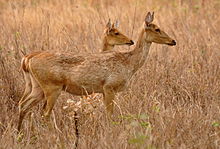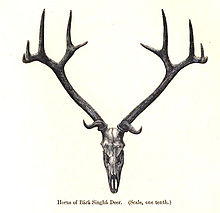Barasingha
| Barasingha | |
|---|---|

| |
| Male | |

| |
| Adult female and yearling | |
| Scientific classification | |
| Domain: | Eukaryota |
| Kingdom: | Animalia |
| Phylum: | Chordata |
| Class: | Mammalia |
| Order: | Artiodactyla |
| Family: | Cervidae |
| Subfamily: | Cervinae |
| Genus: | Rucervus |
| Species: | R. duvaucelii
|
| Binomial name | |
| Rucervus duvaucelii | |

| |
| Historic range (yellow); relict populations: duvaucelii (red); branderi (green); ranjitsinhi (blue) | |
The barasingha (Rucervus duvaucelii), sometimes barasinghe, also known as the swamp deer, is a
The specific name commemorates the French naturalist Alfred Duvaucel.[3]
The swamp deer differs from all other Indian deer species in that the
In Assamese, barasingha is called dolhorina; dol meaning swamp.
Characteristics
The barasingha is a large deer with a shoulder height of 44 to 46 in (110 to 120 cm) and a head-to-body length of nearly 6 ft (180 cm). Its hair is rather woolly and yellowish brown above but paler below, with white spots along the spine. The throat, belly, inside of the thighs and beneath the tail is white. In summer, the coat becomes bright rufous-brown. The neck is maned. Females are paler than males. Young are spotted. Average antlers measure 30 in (76 cm) round the curve with a girth of 5 in (13 cm) at mid beam.[6] A record antler measured 104.1 cm (41.0 in) round the curve.[5]
Stags weigh 170 to 280 kg (370 to 620 lb). Females are less heavy, weighing about 130 to 145 kg (287 to 320 lb).[7] Large stags have weighed from 460 to 570 lb (210 to 260 kg).[4]
Distribution and habitat
Swamp deer were once-common in many areas, including parts of the Upper
In Nepal, they can be primarily found in the western areas of the country, south of the
In 2005, a small population of about 320 individuals was discovered in the Jhilmil Jheel Conservation Reserve in Haridwar district, Uttarakhand, on the east bank of the Ganges. This likely represents the most northerly limit of the species.[15][16]
Distribution of subspecies
Three subspecies are currently recognized:[17]
- Western swamp deer R. d. duvauceli (Cuvier, 1823) – the nominate subspecies, and most abundant, this water-loving deer has splayed hooves and is adapted to the flooded grassland habitat of the Indo-Gangetic plain;[18] in the early 1990s, populations in India were estimated at 1,500–2,000 individuals, and 1,500–1,900 individuals in the Shuklaphanta Wildlife Reserve of Nepal;[9] the latter population reached 2,170 individuals, including 385 fawns, in spring 2013.[19] While few zoos or wildlife parks keep barasingha, internationally, the San Diego Zoo (and its connected Safari Park), in California, United States, has successfully cared-for and bred the western barasingha since the 1970s. Much of their breeding success has been due to the sprawling, naturalistic environment the animals live in, a 150-acre field exhibit called the "Asian Plains"—a setting not unlike their native habitat on the Indo-Gangetic plain. Other Indian species that are mixed with the swamp deer include bharal, blackbuck, chinkara, chital, gaur, hog deer, Indian rhinoceros, nilgai, sambar, tahr and wild boar, as well as sarus cranes.

Adult male barasingha at Kahna National Park, Madhya Pradesh - Southern swamp deer R. d. branderi (Kent, England.[21]
- Eastern swamp deer R. d. ranjitsinhi (Grooves 1982) – is only found in Assam, where the population numbered about 700 individuals in 1978; 400–500 individuals were estimated in Kaziranga National Park at the turn of the century.[9] After a census conducted in 2021, 868 individuals were estimated in the park, with a further 121 in Manas National Park.[22]
Ecology and behaviour

Swamp deer are mainly grazers.[4] They largely feed on grasses and aquatic plants, foremost on Saccharum, Imperata cylindrica, Narenga porphyrocoma, Phragmites karka, Oryza rufipogon, Hygroryza and Hydrilla. They feed throughout the day with peaks during the mornings and late afternoons to evenings. In winter and monsoon, they drink water twice, and thrice or more in summer. In the hot season, they rest in the shade of trees during the day.[9]
In central India, the herds comprise on average about 8–20 individuals, with large herds of up to 60. There are twice as many females than males. During the
When alarmed, they give out shrill, baying alarm calls.[5] Compared to other deer species, barasingha are more relaxed when it comes to guarding. They have fewer sentries and they spend most of their time grazing, unlike deer species like spotted deer or sambar deer.[23]
Threats

The swamp deer populations outside protected areas and seasonally migrating populations are threatened by poaching for antlers and meat, which are sold in local markets. Swamp deer lost most of its former range because wetlands were converted and used for agriculture so that suitable habitat was reduced to small and isolated fragments.[9] The remaining habitat in protected areas is threatened by the change in river dynamics, reduced water flow during summer, increasing siltation, and is further degraded by local people who cut grass, timber and fuelwood,[1] and by illegal farming on government land.[24]
George Schaller wrote: "Most of these remnants have or soon will have reached the point of no return."[7]
Conservation
Rucervus duvaucelii is listed on
An attempt to translocate some individuals to Chitwan National Park in Nepal was unsuccessful.[25]
In captivity
In 1992, there were about 50 individuals in five Indian zoos and 300 in various zoos in North America and Europe.[9]
Swamp deer were introduced to Texas.[26] They exist only in small numbers on ranches.[27]
In culture
- The barasingha is the state animal of the Indian states of Madhya Pradesh and Uttar Pradesh.[28]
- A barasingh (as Kipling writes the name) is mentioned ten times in The Miracle of Purun Bhagat, the second story in The Second Jungle Book. As that part of the story is set in the Himalayas, it is probably meant to be a member of the relict Rucervus duvaucelii duvaucelii population living on both sides of the India – Nepal border.[29]
See also
References
- ^ . Retrieved 15 January 2022.
- OCLC 62265494.
- ^ Cuvier, G. (1823). Recherches sur les ossemens fossiles de quadrupèdes. Vol. Tome Quatrième (Nouvelle édition ed.). Paris, Amsterdam: Dufour & d'Ocagne.
- ^ a b c d Lydekker, R. (1888–1890). The new natural history Volume 2. Printed by order of the Trustees of the British Museum (Natural History), London.
- ^ a b c Prater, S. H. (1948). The book of Indian animals. Oxford University Press. (10th ed.)
- ^ a b c Blanford, W. T. (1888–1891). The fauna of British India, including Ceylon and Burma. Mammalia. Taylor and Francis, London.
- ^ ISBN 0-226-73633-4.
- ^ "Barasingha in March 2013 by janconl". inaturalist.org. April 2020.
- ^ a b c d e f g h Qureshi Q, Sawarkar VB, Rahmani AR, Mathur PK (2004). "Swamp Deer or Barasingha (Cervus duvauceli Cuvier, 1823". Envis Bulletin. 7: 181–192.
- ISBN 81-87498-80-3.
- ISBN 81-900866-0-X
- ^ Choudhury, A. U. (2004). Kaziranga: Wildlife in Assam. Rupa & Co., New Delhi.
- .
- ^ Choudhury, A. U. (1986). Manas Sanctuary threatened by extraneous factors. The Sentinel.
- ^ Tewari, R. and Rawat, G.S. (2013). Activity pattern and diurnal time budget of Swamp Deer (Rucervus duvaucelii duvaucelii) in Jhilmil Jheel Conservation Reserve, Haridwar, Uttarakhand, India. NeBIO 4 (3): 36–40.
- ^ Nandy, S., Kushwaha, S.P.S. and Gaur, P. 2012. Identification of Swamp deer (Cervus duvauceli duvauceli Cuvier) potential habitat in Jhilmil Jheel Conservation Reserve, Uttarakhand, India using multi-criteria analysis. Environmental Management 49 (4): 902–914.
- ^ Groves, C. (1982). "Geographic variation in the Barasingha or Swamp Deer (Cervus duvauceli)". Journal of the Bombay Natural History Society. 79: 620–629.
- ^ a b Pocock R. (1943). The larger deer of British India. Journal of the Bombay Natural History Society 43: 553–572.
- ^ "Shuklaphanta sees increase swamp deer number". The Himalayan Times. 19 April 2013. Archived from the original on 15 June 2013.. Kanchanpur, 19 April 2013.
- ^ Shukla, Rakesh (1 March 2017). "Barasingha breaks new ground". Frontline. Retrieved 3 September 2017.
- ^ "Picture of Barasingha at Port Lympne Wild Animal Park". www.ZooInstitutes.com. Retrieved 5 March 2023.
- ^ Goswami, Roopak (20 January 2022). "Can a big flood push Kaziranga's Eastern Swamp Deer to extinction?". EastMojo. Assam. Retrieved 12 November 2022.
- ^ Menon, Vivek. Indian Mammals: A Field Guide.
- ^ Dabas, H. (12 December 2016). "As Ganga water level dips, farmers encroach land for farming". The Times of India. Bijnor. Retrieved 22 December 2016.
- ^ Abhaya Raj Joshi (27 July 2023). "Translocation hurdles prompt new efforts to save rare swamp deer in Nepal". Mongabay. Retrieved 4 August 2023.
- ^ McCarthy, A., Blouch, R., Moore, D., and Wemmer, C. M. (1998). Deer: status survey and conservation action plan IUCN Deer Specialist Group. IUCN, Gland, Switzerland.
- ISBN 0-643-06714-0.
- ^ "State Animals, Birds, Trees and Flower". www.pannatigerreserve.in. Retrieved 4 April 2018.
- Kipling, Rudyard, The Miracle of Purun Bhagat, in The Second Jungle Book (read online) (accessed 3 May 2024)
Further reading
- M. Acharya, M. Barad, S. Bhalani, P. Bilgi, M. Panchal, V. Shrimali, W. Solanki, D.M. Thumber. Kanha Chronicle. United States National Park Service.


